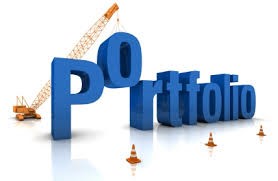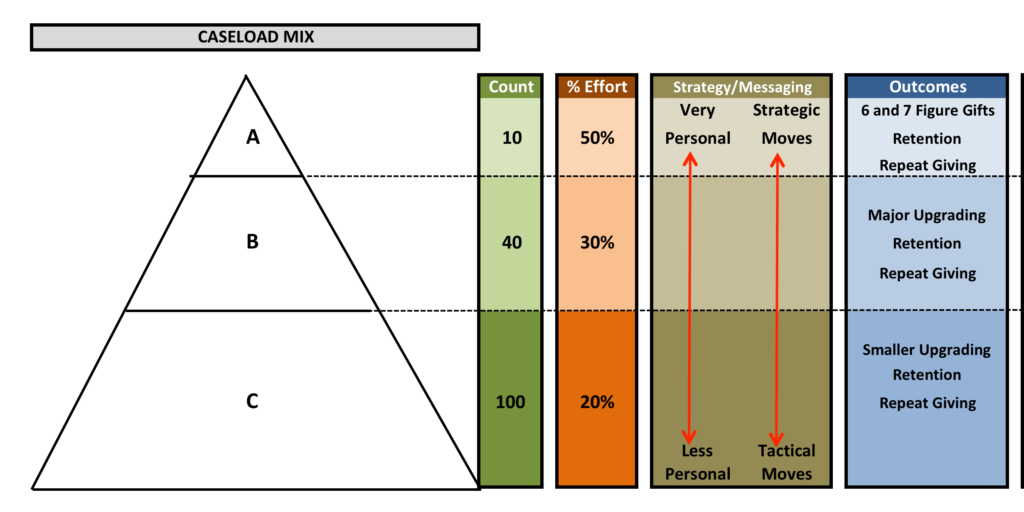
How to Effectively Manage Your Portfolio, Part 2
Have you been treating all of your donors the same?
Before I start working with an MGO to help her put a structure to her caseload, I always ask her to tell me how she currently works with her portfolio, and to tell me about a recent gift she solicited.
I’ll never forget one MGO who told me very excitedly about a gift she had just solicited from a donor. She had worked with this donor for months. She must have had four or five face-to-face meetings, did all this research, created a 4-page proposal… it was incredible. I then asked, “how much did you solicit the donor for?” Her response: “$1,500.”
I tried not to show my shock.
I knew already that she had donors on caseload that were giving high five- and low six-figure gifts. So I asked her about one particular donor who had given $25,000 consistently over the three years, and what she had been doing to cultivate that donor. She said, “well, that person is always going to give $25,000 no matter what I do, so I don’t really spend a bunch of time on her.”
Huh? I said to her. “You just spent a bunch of your time and energy, in addition to your organization’s money for your salary, to solicit a donor for $1,500 – when you have donors who give $25k, $50k and $100k per year, and you barely move a muscle for them? We’ve got to turn that around.”
This story highlights what is happening in major gift officers’ portfolios across the country. MGOs are not focusing their time and energy correctly on the donors that are or could be giving substantial amounts of revenue to their organizations, because they have not tiered their donor file.
But after my last post, you have now tiered them correctly, right? Awesome. So how do you work with your “A” level donors? Let’s first look again at the illustration below:

In this portfolio just 10 donors make up Tier A. It would be fine if it were up to 20 or 25 in your portfolio. Just be aware that your Tier A donors will generally produce 50-60% of the total revenue that is generated from your entire portfolio of 150 donors.
This means that 50% or more of your time has to be spent on these donors. When I say this to MGOs, they think I’m crazy. “50% of my time on 20 donors? What am I going to do to fill that time?”
Don’t worry about it. Before you are done reading this post, you will know exactly what will take up all that time. But I want to make sure you let this sink in a bit. This means that in a typical workweek, 20+ hours are devoted to your “A” level donors. That’s 2.5 days a week, that is two weeks of every month, that is six months of every year working with anywhere between 10-25 donors. Got it?
Now here is what you can do with your “A” level donors:
- Long-range plans – Assuming of course you have a yearly revenue goal and strategic plan for every one of them (this is the basics here), you are also going to create a 3-5 year growth plan for where you want to take each of your “A” level donors. Why? Because these are the donors that are the most invested with you, and they have the most capacity to create enormous net revenue for your programs.
- Identify 2-3 donors who can give transformational gifts. These are the donors who, if you spent the time and effort to really understand their stories and properly steward and cultivate the relationships, over the next 2-3 years they could give your organization a substantial, life-changing gift. Once you identify those 2-3 donors, you will create (in addition to your detailed yearly plan for them) a detailed 3-year plan that includes growing that relationship and working with leadership and program to identify just the right program or project that will match their passions enough that they will want to transform your organization (and their lives) with a really substantial gift.
- Thanking — Every “A” level donor in your portfolio should have a “gratitude plan” attached to them. This means you have a specific, individual protocol for thanking when any one of them gives a gift. For example, if you obtain a gift from Ms. Smith, she always gets a call from the CEO. If Mr. Jones gives a gift, he enjoys getting a handwritten note from the chair of the board. In addition, you are personally thanking your “A” level donors throughout the year even when they don’t make a gift. This is done through phone calls, personal notes, face-to-face visits, video, etc.
- Reporting on impact — This is critical. With your “A” level donors, the way you report on impact is highly specific to their gifts. You cannot treat all of your donors the same here. As you know, donors want to know what kind of impact they are making. You cannot give a general impact report to these folks. So you must spend time with program to really understand the impact of the gift as best you can. It means working with finance to understand the financial impact of the gift.
- Understanding the donor’s story — This goes beyond understanding the passions and interests of your donors. Knowing your donor’s story helps you understand why she has those passions and interests, and it allows you to craft very specific offers that your donor will be excited to invest in. For every “A” level donor, you should have in your database a very detailed, written story on why your donor supports you. This story will drive everything you do with that donor, as you will come back time and time again to remind the donor that you know her.
- Researching programs and projects — With the donor’s story in mind, you will need to spend significant time researching all of your organization’s programs and projects. If you are working on one of those mega or transformational gifts, your program team may have to design a new program, one that still works within the mission of your organization. It takes a lot of time and effort to help shepherd that along.
- Communicating to leadership — It’s incredibly important that you are communicating up to your boss, leadership and board regarding your “A” level donors. Inevitably, you will be asking for their participation in helping you cultivate and steward these donors. Along with meeting weekly with your manager, you should create a detailed monthly report that goes to your ED or CEO. This allows you to be proactive and relay information that is useful. It will help you obtain new strategies from leadership on how best to cultivate your donors. There is no down side to proactively communicating with leadership.
- High level of service — Think of your “A” level donors as your VIP list of donors. Remember, these donors are creating over half of the overall revenue in your portfolio. If you know your donor, you know what types of hobbies he has, what schools he went to, what his birthday and anniversary dates are, what his business is, etc. You will use all of that information to create “touches” throughout the year that are very personal, heartfelt and meaningful for your donors. As their personal contact with the organization, you are always thinking of ways to engage your “A” level donors and even to connect your donors with each other. You want to create an experience for your donor that is unlike any other organization they are involved in.
So now you know what takes up 50% of your time with 10-25 donors. It’s a tremendous amount of work. However, if you stay focused, you will see higher retention rates and ever-increasing gift value from these donors. Love your “A” level donors, and they will love you back.
Jeff







0 Comments